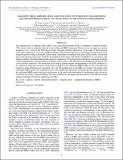Magnetic field amplification and evolution in turbulent collisionless magnetohydrodynamics : an application to the intracluster medium
Abstract
The amplification of magnetic fields (MFs) in the intracluster medium (ICM) is attributed to turbulent dynamo (TD) action, which is generally derived in the collisional-MHD framework. However, this assumption is poorly justified a priori, since in the ICM the ion mean free path between collisions is of the order of the dynamical scales, thus requiring a collisionless MHD description. The present study uses an anisotropic plasma pressure that brings the plasma within a parametric space where collisionlessinstabilities take place. In this model, a relaxation term of the pressure anisotropy simulates the feedback of the mirror and firehose instabilities, in consistency with empirical studies. Our three-dimensional numerical simulations of forced transonic turbulence, aiming the modeling of the turbulent ICM, were performed for different initial values of the MF intensity and different relaxation rates of the pressure anisotropy. We found that in the high-β plasma regime corresponding to the ICM conditions, a fast anisotropy relaxation rate gives results that are similar to the collisional-MHD model, as far as the statistical properties of the turbulence are concerned. Also, the TD amplification of seed MFs was found to be similar to the collisional-MHD model. The simulations that do not employ the anisotropy relaxation deviate significantly from the collisional-MHD results and show more power at the small-scale fluctuations of both density and velocity as a result of the action of the instabilities. For these simulations, the large-scale fluctuations in the MF are mostly suppressed and the TD fails in amplifying seed MFs.
Citation
Santos-Lima , R , De Gouveia Dal Pino , E M , Kowal , G , Falceta-Gonçalves , D , Lazarian , A & Nakwacki , M S 2014 , ' Magnetic field amplification and evolution in turbulent collisionless magnetohydrodynamics : an application to the intracluster medium ' , Astrophysical Journal , vol. 781 , no. 2 , 84 . https://doi.org/10.1088/0004-637X/781/2/84
Publication
Astrophysical Journal
Status
Peer reviewed
ISSN
0004-637XType
Journal article
Description
R.S.L. acknowledges support from a grant of the Brazilian Agency FAPESP (2007/04551-0 and 2013/15115-8), EMGDP from FAPESP (2006/50654-3 and 2011/53275-4) and CNPq (306598/2009-4) grants. G.K. also acknowledges support from FAPESP (2009/50053-8, 2013/04073-2, and 2013/18815-0). D.F.G. thanks the European Research Council (ADG-2011 ECOGAL) and the Brazilian agencies CNPq (no. 300382/2008-1), CAPES (3400-13-1), and FAPESP (no.2011/12909-8) for financial support. A.L. acknowledges the NSF grant AST 1212096, the NSF-sponsored Center for Magnetic Self-Organization, as well as the stimulating atmosphere of the International Institute of Physics (Natal, Brazil) and of the Harvard University during his sabbatical, and of the Vilas Associate Award. M.S.N. acknowledges support from FAPESP (2010/50298-8). The numerical simulations of this work were performed with the supercomputer of the Laboratory of Astro-informatics LAi (IAG/USP, NAT/Unicsul), whose purchase was made possible by FAPESP (grant 2009/54006-4).Collections
Items in the St Andrews Research Repository are protected by copyright, with all rights reserved, unless otherwise indicated.

